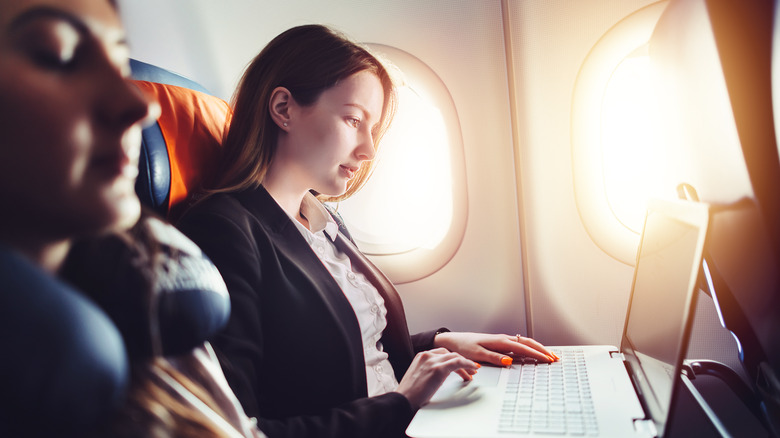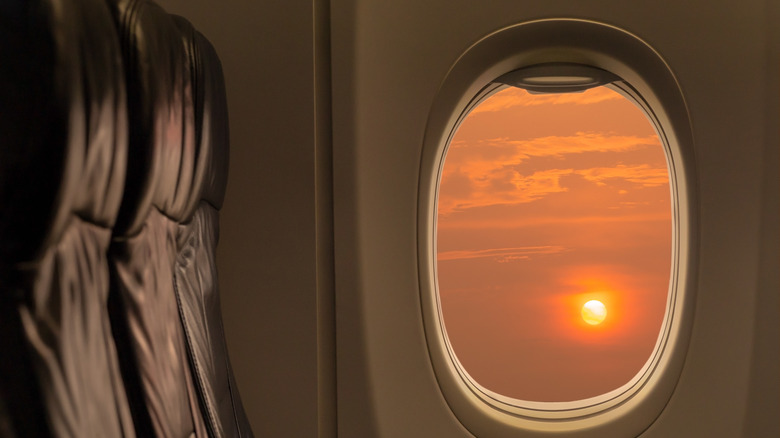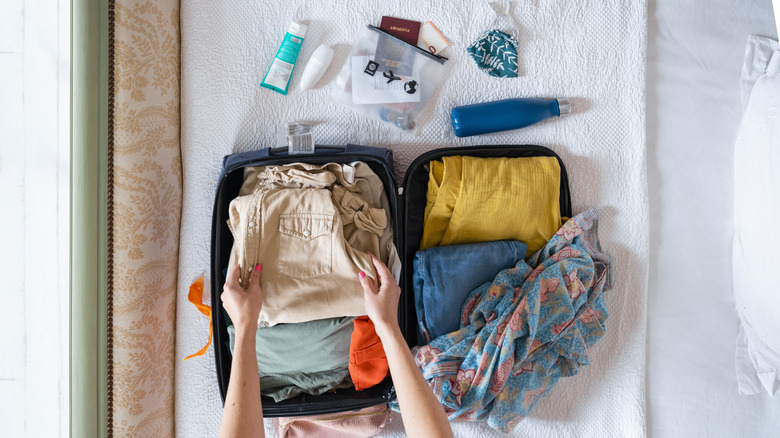Why You May Not Want To Book The Window Seat On Your Next Flight
When it comes to choosing airplane seats, people fall into two teams only: aisle or window seat (middle seat is a "nope"). For window seats, the birds-eye views and the ability to lean against the cabin wall for some shut-eye are undeniable perks. However, there's a major downside to the window seat — beyond the hassle of asking fellow passengers to move when you need to use the restroom. As it turns out, you may not want to book the window seat for your next flight because of the damage it can do to your skin.
Most of us are aware of the dangers of excessive sun exposure. UV (ultraviolet) rays, both UVA and UVB, are responsible for causing sunburn, premature aging, and increasing the risk of skin cancer. Many travelers don't realize that even when safely tucked inside an aircraft at 30,000 feet, you're still exposed to these harmful rays. Dermatologist Dr. Kenneth Mark tells Newsweek that "for every 1,000 feet increase in altitude, the sun's intensity increases almost 10%." You can do the math here!
Aircraft windows are designed to provide passengers with clear views and protection against the elements, but they don't entirely block out UV radiation. While the windows do offer some protection against UVB rays, they are far less effective at blocking UVA rays. In fact, UVA rays can transmit through airplane windows in a range of 0.41% to a whopping 53.5%. This means that if you're by the window, you're getting a non-stop low-level dose of UVA radiation throughout your flight.
The invisible UV threat at 30,000 feet
Occasional exposure to the sun might not seem harmful. But what about the frequent fliers, business travelers, or those on long-haul flights? The cumulative exposure to UVA rays, which is also the main source of radiation in tanning beds, has been proven to lead to significant skin damage time and time again. Chronic exposure accelerates skin aging, causing wrinkles, sunspots, and loss of skin elasticity. And the arid 20% humidity in the airplane (literally drier than the Sahara Desert, according to The New York Times) doesn't help your skin either!
Furthermore, a study published in JAMA Dermatology found that pilots and cabin crew have twice the risk of melanoma, the most lethal type of skin cancer. While the study primarily looked at the occupational hazards of regular flying, this devastating statistic underscores the risk of prolonged exposure to UV radiation at high altitudes. Even if the risk seems small on a single flight, it can accumulate for frequent window-seat travelers.
You may think that pulling down the shades eliminates this risk. However, the answer is no. The little plastic guard may block out some UV, but those pesky UVB rays will still push through. Dermatologist Dr. Dennis Gross explains, "Unless your airplane blinds are made of metal, which reflects all UV, they won't completely block out all those rays" (via The Cut). That said, you are better off pulling down those shades, especially when it's sunny, but regardless of the weather. Clouds and snow can also reflect UV rays, so there's really no escape.
Sunscreen: a must-have for flights
But there's some good travel news — there have been very exciting developments in the realm of next-gen aircraft windows, with nearly 99% UV+ blocking technology, fancy electronically dimmable windows, and even better-engineered cockpit windows for pilots. Some of these technologies will be offered on the breakthrough Boeing 777X, set to hit the skies sometime in 2025.
But until then, the solution is simple: wear sunscreen. Unfortunately, most passengers don't even consider applying sunscreen for a flight, relegating it to days at the beach. If you're devoted to the window seat or flying frequently, it's crucial to incorporate generous slathers of sunscreen into your airborne routine. Dr. Jennifer Gordon, a board-certified dermatologist with Westlake Dermatology in Austin, Texas, exclusively tells Explore, "You should always have SPF of at least 30 on your face and exposed areas every day, especially when flying."
Ensure that your chosen sunscreen offers broad-spectrum protection, guarding against both UVA and UVB rays. SPF only indicates protection against UVB rays, and you should always check the label to confirm that there's UVA protection. As far as application goes, Dr. Gordon recommends that you "Reapply every two hours and protect your eyes if possible". A 3.4-ounce travel-size sunscreen should do the job. Perhaps you're familiar with the iconic 90s Baz Luhrmann song "Everybody's Free" which opens with "If I could offer you only one tip for the future, sunscreen would be it" — and we couldn't agree more.


